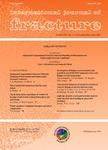版权所有:内蒙古大学图书馆 技术提供:维普资讯• 智图
内蒙古自治区呼和浩特市赛罕区大学西街235号 邮编: 010021

作者机构:Hassan II Univ ENSEM Lab Control & Mech Characterizat Mat & Struct Casablanca Morocco
出 版 物:《INTERNATIONAL JOURNAL OF FRACTURE》 (国际断裂杂志)
年 卷 期:2021年第231卷第1期
页 面:1-20页
核心收录:
学科分类:08[工学] 0805[工学-材料科学与工程(可授工学、理学学位)] 0801[工学-力学(可授工学、理学学位)]
主 题:Delamination Fracture toughness FEM simulation Cohesive zone model Fracture surface
摘 要:The characterization and modeling of Ceiba plywood delamination requires extensive experimental and numerical study. A data reduction scheme, based on the compliance method and the concept of equivalent crack, is utilized. This method has two main advantages over conventional methodologies: it does not require crack monitoring during propagation and takes into account the effect of the fracture process zone at the crack tip. The characterization of delamination and the mechanical behavior of adhesive joint are influenced not only by the adhesive properties but also by the characteristics of the interface. Various modeling methods have been proposed to characterize the delamination of laminated materials. Among the most widely used methods is the cohesive zone model, which is based on fracture mechanics and damage theory and allows for an adequate prediction of the onset and propagation of the delamination simultaneously. This method consists of introducing a cohesion law in finite element modeling. Often, the determination of these parameters is obtained iteratively by matching the numerical results with the experimental results. In this study, the cohesive parameters of the bilinear traction-separation laws in each pure mode were determined. This identification was achieved through the design of experiments method and the Kriging metamodel. A finite element modeling of the Ceiba plywood delamination was then performed. The experimental tests carried out make it possible to assess the delamination resistance under mode I, mode II and mixed mode I + II loading. Following the description of the experimental procedure, the experimental and numerical results are presented and compared. Finally, the response to the delamination was represented by a semi-empirical criterion and an analysis of fracture surfaces was performed and interpreted.